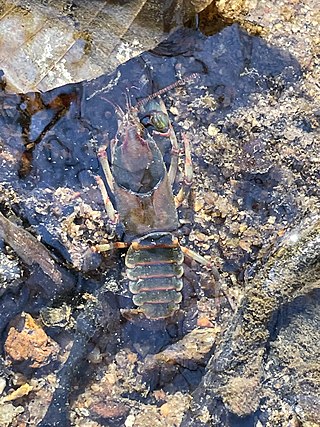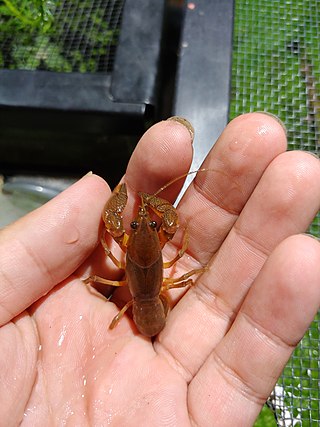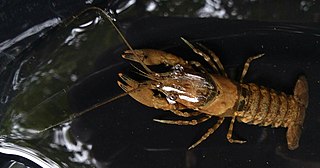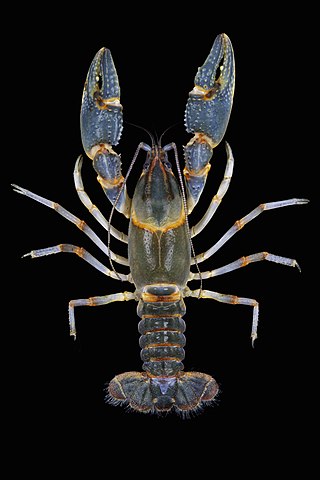
Cambarus is a large and diverse genus of crayfish from the United States and Canada. The adults range in size from about 5 cm (2.0 in) up to approximately 15 cm (5.9 in).
Cambarus chaugaensis, the Chauga crayfish or Chauga River crayfish, is a species of crayfish in the family Cambaridae. It is endemic to the Carolinas in the United States of America. The common and scientific names refer to the Chauga River of South Carolina, where the first specimens were collected.
Cambarus coosawattae, the Coosawattae crayfish, is a species of crayfish in the family Cambaridae. It is endemic to Georgia. The common name refers to the Coosawattee River, with the original specimens being collected in the Cartecay River which combines with another river to form the Coosawattee.

Cambarus howardi, the Chattahoochee crayfish, is a species of crayfish in the family Cambaridae. It is found in North America. The common name refers to the Chattahoochee River, where the first specimens were collected.

Lacunicambarus miltus, the rusty gravedigger, is a species of crayfish in the family Cambaridae. It is found in the southeastern United States.

Cambarus scotti, the Chattooga River crayfish, is a species of crayfish in the family Cambaridae. It is endemic to Alabama and Georgia. The common name refers to the Chattooga River. The original specimens were collected from Clarks Creek in Chattooga County.
Fallicambarus harpi, the Ouachita burrowing crayfish, is a species of crayfish in the family Cambaridae. It is known only in southwest Arkansas. The species is a primary burrower, located in low lying seepage areas in pastures, yards and lawns.
Faxonius wrighti, the Hardin crayfish, is a species of crayfish in the family Cambaridae. It is endemic to the United States. The common name refers to Hardin County, Tennessee, where the original specimens were found.

Procambarus is a genus of crayfish in the family Cambaridae, all native to North and Central America. It includes a number of troglobitic species, and the marbled crayfish (marmorkrebs), which is parthenogenetic. Originally described as a subgenus for four species, it now contains around 161 species.

Lacunicambarus diogenes, the devil crayfish,devil crawfish, is a species of North American burrowing crayfish found in the Atlantic Coastal Plain and parts of the Piedmont ecoregion from New Jersey, Pennsylvania, Delaware, Maryland, Virginia, North Carolina, South Carolina, Louisiana, and Georgia.

Lacunicambarus acanthura, the thornytail crayfish, is a species of crayfish in the family Cambaridae. It is found in the southeastern United States.
Faxonius alabamensis, the Alabama crayfish, is a species of freshwater crayfish that lives in Alabama, Mississippi and Tennessee.

Faxonius erichsonianus is a species in the family Cambaridae ("crayfishes"), in the order Decapoda. A common name for Faxonius erichsonianus is reticulate crayfish. Faxonius erichsonianus is found in the south eastern United States of America.

Faxonius is a genus of freshwater crayfish in the family Cambaridae. There are more than 90 described species in Faxonius. It includes the rusty crayfish, an invasive species in North America, and three species, F. virilis, F. immunis, and F. limosus, that are invasive to Europe.

Creaserinus is a genus of Digger Crayfish in the family Cambaridae. There are about 15 described species in Creaserinus, found in North America.

Lacunicambarus freudensteini, the banded mudbug, is a species of North American burrowing crayfish found in Alabama and Mississippi.
Faxonius sanbornii erismophorous is a sub-species of crayfish in the family Cambaridae. It is endemic to the United States.

Cambarus monongalensis, the blue crayfish or Monongahela crayfish, is a species of burrowing crayfish native to Pennsylvania and West Virginia. It has also been found recently in Ohio. The common name refers to the Monongahela River, with the first specimens being collected from Edgewood Park, Allegheny County, Pennsylvania. It is included on the IUCN Red List as a species of Least Concern.
Cambarus loughmani, the blue Teays mudbug, is a species of burrowing crayfish endemic to the pre-glacial Teays River Valley in West Virginia. The species was previously considered to be part of the Cambarus dubius complex.

Lacunicambarus chimera, or the Crawzilla crawdad, is a species of cambarid crayfish endemic to the U.S. states of Illinois, Indiana, Kentucky, Missouri, and Tennessee.














